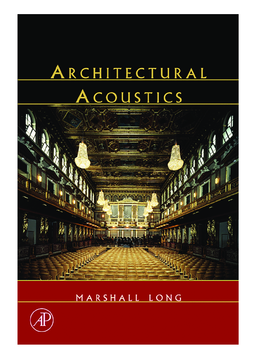
Additional Information
Book Details
Abstract
Architectural Acoustics offers a comprehensive overview of acoustical science at a level suitable for either advanced undergraduate or introductory graduate courses in architectural design and architectural engineering. The text is organized according to how sound interacts with built structures, going from simple geometries through complex building structures. The book begins with a brief but useful history of architecture and the role of acoustics, as well as overview of human perception of, sound, and then progresses through topics ranging from acoustic measurement, noise metrics and environmental noise, to sound in enclosed spaces, sound transmission in buildings, vibration and vibration isolation, and noise in mechanical systems.
Architectural Acoustics also includes more advanced chapters on specific design problems, including treatment of multifamily dwellings, office buildings, sound reinforcement systems, rooms for music, multipurpose rooms, auditoriums, sanctuaries, and studios and listening rooms. Also covered is the theory loudspeaker systems and sound system modeling as well as in-depth presentation of computer modeling, ray tracing and auralization.
* Comprehensive guide to the basics of acoustical science and its applications to architectural design.
* Author is renowned expert engaged in acoustical engineering for 20 years
* Covers the latest environmental regulations and health and safety research related to sound inside and outside of buildings.
“A very comprehensive compendium of information that would be a valuable resource for an acoustical consultant."
— John Bradley, Institute for Research in Construction, Journal of the Acoustical Society of America, July 2006
“ ... a welcome addition to the general acoustical iterations as well as to the desktop reference collection of practicing acousticians. It is voluminous, full of clear figures, and written in a rigorous but comfortable style.
— John Eargle, J. Audio Eng. Soc., Vol 54, No. 7/8. 2006 July/August
“This is one of those useful ‘compilation’ books which collate information from many other texts, resulting in the typical response to a design office query: “It’s probably in Marshall Long.
— Journal of Sound and Vibration, 22 December 2006
